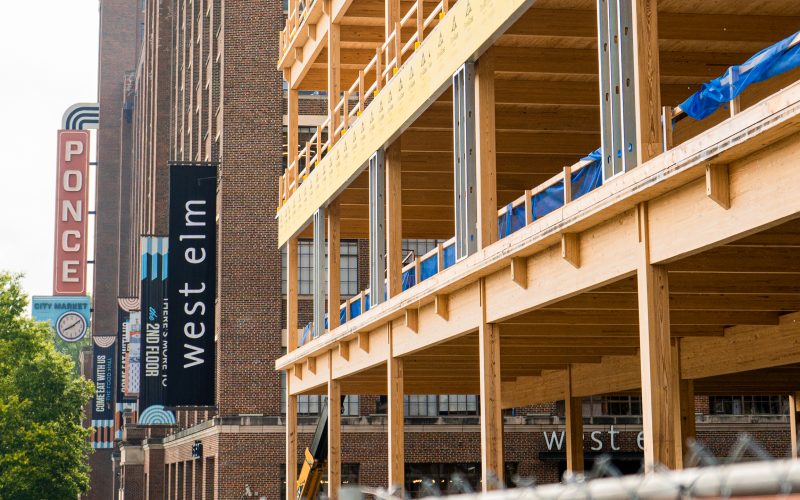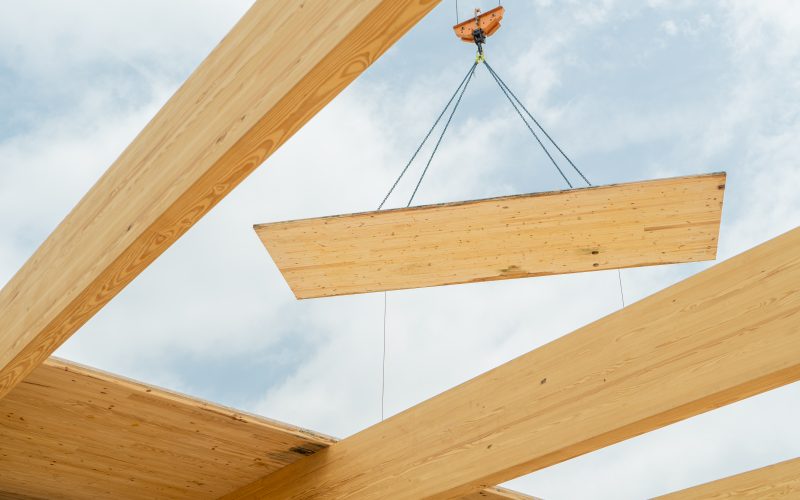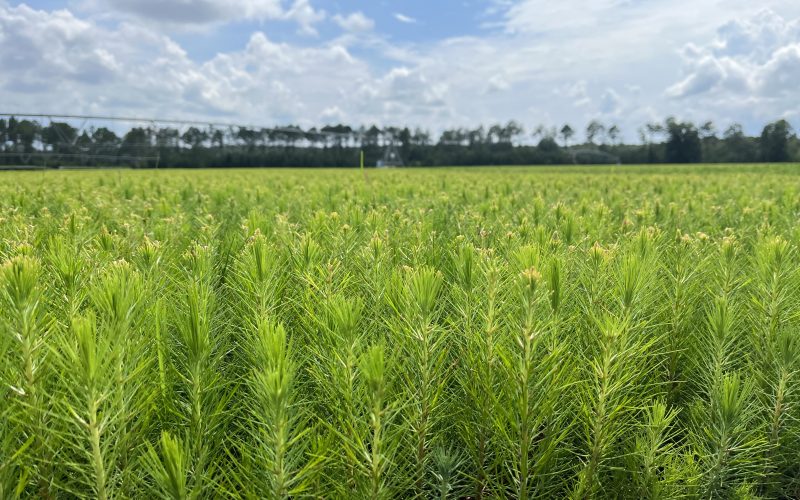The Future of Southern Forests Hinges on Showcasing their Value
Aerial photos of Stanton Springs, an industrial compound near I-20 in Newton County, make for an incongruous image. The development is 1,600 acres of buildings and parking lots nested within woods; a gash in a sea of green. Those who view Georgia through the lens of its forests can see a specter in the lush landscape that surrounds this recently built complex. Inevitably, they know, more of that forestland will be sold to build homes and other community necessities for Stanton Springs’ workers. The trees, in other words, will have to go so humans can move in.

On one hand, this industrial park and the ripples of development it may beget represent the promise of Georgia as a magnet for movers and shakers, workers and families. The Atlanta Regional Commission predicts an influx of 2.9 million people to metro Atlanta by 2050.
“Everyone wants to live here,” confirms Daniel McInnis, shared stewardship coordinator at the U.S. Forest Service. “Our population continues to expand and you need a place for these folks to live, shop, go to church…”
On the other hand, developments like Stanton Springs are the embodiment of a chilling prediction made by the Southern Forest Futures report. The 2013 study by the U.S. Forest Service had this tagline: If the trends and practices of the early 2010s were to continue, the 13-state Southeastern region was in danger of losing 23 million acres of forestland to urban development.
So far, in the 2020s, those trends and practices don’t seem to be reversing course, though we’ll know for sure in 2022, McInnis notes, when the Forest Service will release a study update called the Southern Forest Outlook.
Here’s what we do know:
- A 26-year supply of pine on the stump means our current low timber prices could stay down for a long while.
- Land prices are up, driven in part by pandemic-era remote workers fleeing cities for cheaper, roomier suburbs and rural areas.
- Georgia’s forest owners are aging. When the Forest Service conducted a demographic study in 2008, almost half of forest owners were retirees. That number has surely increased in 2021.
So, when turf-hungry developers make generous offers on forestland, some landowners are finding the deals hard to resist.
HELPING LANDOWNERS KEEP THEIR FORESTS
“I think landowners are caught between a rock and a hard spot,” observes Scott Davis, a Nature Conservancy veteran who now leads strategic initiatives at Keeping Forests, a high-impact coalition of conservationists and business leaders. “They’re passionate about their land, but at the same time, they have to make a living and have to pay their taxes.”
Thus, Keeping Forests and a host of other conservationists and forestry organizations are devising options for landowners who want to hang on to their forests during this challenging cycle.
The first step is hammering home the stakes.
Ecologically, we know that forest-to developed-land conversion damages wildlife habitats, carbon and water sources. Another well-known conservation value is keeping forestland contiguous to maintain wildlife corridors, waterways and other ecosystem essentials.
Approaching conservation with such big-picture ideals is important. But equally vital, contends Katherine Moore, president of the Georgia Conservancy, is honing in — saving the most ecologically significant areas that are most at risk.
“There are types of land sinks that are better from a carbon perspective, where we want to make sure we’re getting the biggest bang for the land conservation buck,” she says. “One area where we’re seeing Atlanta metro growth, for instance, is in North Georgia and the piedmont region. That’s where our state’s densest forest is. So, loss of forestland there is more meaningful.”
The economic hit of forest loss is significant as well. As the Southern Forest Futures report outlines, 86% of the South’s forests are privately owned and two-thirds of those owners harvest and sell their trees.
In an April interview on the Keeping Forests podcast How the River Flows, Davis noted that there’s a cultural risk as well.
“I want my kids and grandkids to be able to understand … if we don’t have ways of mitigating climate change, keeping our water clean and thinking about the wildlife habitat species diversity that are captured in these forests, then we’ve lost something that’s really, really important,” he said. “I want them to have the physical experience of being in the woods, but I also want them to have that leading edge that has begun to think about forests as some of the most important natural systems that we have, that deserve our attention, our investment and our protection.”
The futures report, Davis says, was one of the things that inspired the creation of Keeping Forests, which has organized its efforts into three categories: Promoting forest products, creating emerging markets and generating critical mass.
The report has galvanized a host of other stakeholders as well.
The Georgia Conservancy, for instance, is developing an online tool to aid leaders as they strategize for land use policy and investment. The tool, called Georgia Now and Forever, will quantify land-use changes in every single Georgia county, breaking down the data by categories that range from grassland and wetlands to developed land and, of course, forests.
“No jurisdiction has seen a decrease in development. Everywhere has seen an increase,” notes a summary in the site’s beta version. “Forest and working farmland are being lost at rates of 133 acres/ day and 172 acres/day respectively.”
FORESTS AS FUNDAMENTAL INFRASTRUCTURE
Another new enterprise comes from the Georgia Forestry Foundation, which asked former director of the Georgia Forestry Commission Robert Farris to step into a role called “forest ecosystem services program manager.”
“We’ve heard from landowners about the timber price challenges,” Farris says. “They’re asking, ‘How can we develop and improve markets to keep our forests forests?’’
Farris’s answer: entice water utilities to pay forest owners to keep their land in trees. “Forests are the best use of land for protecting water quality,” he explains.
“They filter the water and control the flow to our streams. Nothing compares to it. The question for the water utilities is how much more is it going to cost them to clean and process that water coming off a Walmart parking lot.”
Monetizing forests’ water “services” is akin to selling trees’ “carbon credits,” which has been growing in popularity with corporations looking to offset their carbon footprints.
Another promising effort, says Andres Villegas, president and CEO of the Georgia Forestry Association, is the promotion of mass timber construction, a building technique that expands the timber market and is sustainable, architecturally exciting and increasingly embraced by government regulators.
“Just this week, we visited a building in Washington, DC where they’re adding three stories onto a six-story building with mass timber technology,” Villegas said in late April. “You can’t do that with steel and concrete. It’s too heavy. Wood is just as strong but lighter. This means we can expand on current urban footprints without taking new land from other places.”
Put another way, Villegas says, “It could mean less of a concern about the acre for- acre transfer of forestland for urban growth. It’s more about how we grow.”
Moore agrees that development in and of itself isn’t a bad thing. Efficient, thoughtful growth, she says, with an eye on infill construction and redevelopment and re-use of existing buildings, can prevent the need for expansion into forested land.
“If we’re going to have a more resilient climate and growth future,” she says, “we need to think in terms of a three-legged stool. Those three pieces are land conservation, sustainable land use and land stewardship.”
All three of those values point to preserving forests not just for their own sake, but for the sake of what Davis calls the “critical infrastructure” that forests provide to all walks of life. Viewing forests in such a way, he says, requires a paradigm shift.
“I’ll be honest,” he says. “A lot of people, especially younger people, when they see a truck full of logs, they see a truck full of dead bodies. ‘They’re cutting down the forests!’ And there are pieces of land that should stay parks and natural preserves because they’re so important biologically and ecologically. But what we have to understand is, these lands depend on the working landscapes that surround them. And that’s where the leadership has to come in and help people understand that working forests are a critical component of conservation.”
It all boils down to this: helping landowners hang on to their trees depends on looking at forests in a new way.
They’re infrastructure, as fundamental to modern life as roads and electric grids. They’re providers of carbon sequestration, air and water purification and biodiversity preservation, “services” that are financially valuable — and viable. They’re a resource that can support and innovate existing urban environments — and save themselves in the process.
Brooks Mendell, president and CEO of forest supply forecasting and strategy firm Forisk Consulting, says he hasn’t lost faith in the idea of forests as timber farms, despite current tribulations.
“While low timber prices can be frustrating,” he says, “they’re also attracting mills. In big swaths of south Georgia, we’ve had so much investment in mills. The moving of mills near the forests gives us comfort and confidence that the forests will stay there in the future.”
Another article of faith is the dedication of the landowners, as well as the conservationists and capitalists — once a most unlikely alliance — banding together to support them.
“We can confirm that forest owners love having forests,” Mendell says. “They like to replant their trees and manage them productively. We know this. We have the data. The land ethic and the commitment families have to the land is a beautiful, important piece of the forest story.”







